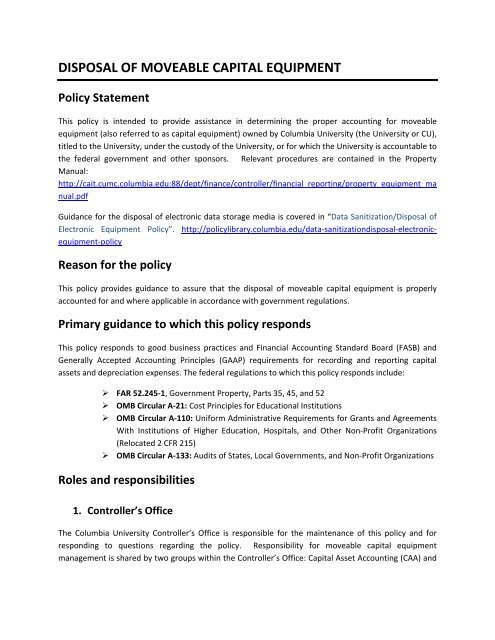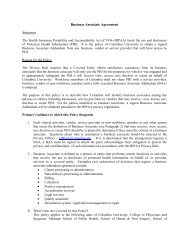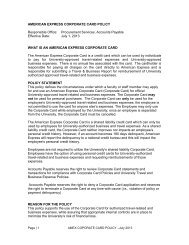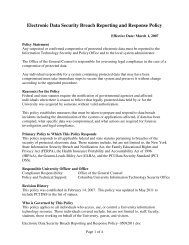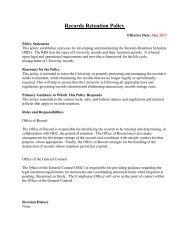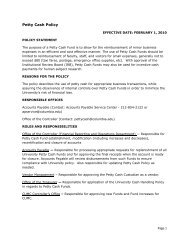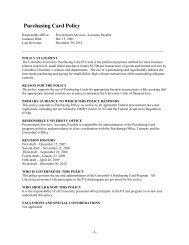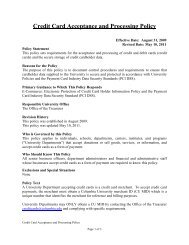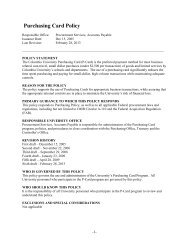Full Policy Text - Columbia University Administrative Policy Library
Full Policy Text - Columbia University Administrative Policy Library
Full Policy Text - Columbia University Administrative Policy Library
Create successful ePaper yourself
Turn your PDF publications into a flip-book with our unique Google optimized e-Paper software.
DISPOSAL OF MOVEABLE CAPITAL EQUIPMENT <br />
<strong>Policy</strong> Statement <br />
This policy is intended to provide assistance in determining the proper accounting for moveable <br />
equipment (also referred to as capital equipment) owned by <strong>Columbia</strong> <strong>University</strong> (the <strong>University</strong> or CU), <br />
titled to the <strong>University</strong>, under the custody of the <strong>University</strong>, or for which the <strong>University</strong> is accountable to <br />
the federal government and other sponsors. Relevant procedures are contained in the Property <br />
Manual: <br />
http://cait.cumc.columbia.edu:88/dept/finance/controller/financial_reporting/property_equipment_ma<br />
nual.pdf <br />
Guidance for the disposal of electronic data storage media is covered in “Data Sanitization/Disposal of <br />
Electronic Equipment <strong>Policy</strong>”. http://policylibrary.columbia.edu/data-‐sanitizationdisposal-‐electronic-equipment-‐policy<br />
<br />
Reason for the policy <br />
This policy provides guidance to assure that the disposal of moveable capital equipment is properly <br />
accounted for and where applicable in accordance with government regulations. <br />
Primary guidance to which this policy responds <br />
This policy responds to good business practices and Financial Accounting Standard Board (FASB) and <br />
Generally Accepted Accounting Principles (GAAP) requirements for recording and reporting capital <br />
assets and depreciation expenses. The federal regulations to which this policy responds include: <br />
FAR 52.245-‐1, Government Property, Parts 35, 45, and 52 <br />
OMB Circular A-‐21: Cost Principles for Educational Institutions <br />
OMB Circular A-‐110: Uniform <strong>Administrative</strong> Requirements for Grants and Agreements <br />
With Institutions of Higher Education, Hospitals, and Other Non-‐Profit Organizations <br />
(Relocated 2 CFR 215) <br />
OMB Circular A-‐133: Audits of States, Local Governments, and Non-‐Profit Organizations <br />
Roles and responsibilities <br />
1. Controller’s Office <br />
The <strong>Columbia</strong> <strong>University</strong> Controller’s Office is responsible for the maintenance of this policy and for <br />
responding to questions regarding the policy. Responsibility for moveable capital equipment <br />
management is shared by two groups within the Controller’s Office: Capital Asset Accounting (CAA) and
Research <strong>Policy</strong> & Indirect Cost (RPIC). This structure is designed to ensure both financial and <br />
government policies and procedures regarding equipment are addressed. <br />
Capital Asset Accounting (CAA) <br />
CAA is the primary group responsible for capital equipment management at the <strong>University</strong>. The <br />
CAA Property Manager serves as the primary liaison to schools and departments for all capital <br />
equipment related processes and is responsible for ensuring compliance with Generally <br />
Accepted Accounting Principles and government regulations for capital equipment management <br />
at the <strong>University</strong>. <br />
Research <strong>Policy</strong> & Indirect Cost (RPIC) <br />
The overall responsibility of RPIC is to provide annual and final property reports for Government <br />
Owned/Furnished Equipment . <br />
2. Custodial Departments <br />
Chairpersons, deans and directors have general stewardship responsibilities for the maintenance and <br />
control of all capital equipment in their custody and control. A departmental equipment coordinator or <br />
equivalent is responsible for the disposal of equipment at the department level. <br />
Revision history <br />
None <br />
Who is governed by this policy <br />
This policy applies to all individuals who have custody, use or control capital equipment owned by the <br />
<strong>University</strong>, titled to the <strong>University</strong>, under the custody of the <strong>University</strong>, or for which the <strong>University</strong> is <br />
accountable to the federal government and other sponsors. Covered individuals include, but are not <br />
limited to, faculty, staff, students, contractors, consultants, those working on behalf of the <strong>University</strong> <br />
and/or individuals authorized by affiliated institutions and organizations. <br />
Who should know this policy <br />
Anyone who has custody, uses or controls capital equipment owned by the <strong>University</strong>, titled to the <br />
<strong>University</strong>, under the custody of the <strong>University</strong>, or for which the <strong>University</strong> is accountable to the federal <br />
government and other sponsors.
Exclusion or special situations <br />
None <br />
<strong>Policy</strong> <strong>Text</strong> <br />
A. Methods of Disposal <br />
Disposal of capital equipment is governed by the source of funding for equipment. All disposals should <br />
be conducted in accordance with the guidance provided by the relevant documents for the capital <br />
equipment. Contact Sponsored Project Administration (SPA) to help determine if there is a restriction on <br />
a type of disposal (for example, a donation that cannot be sold). Once any restrictions have been <br />
addressed, the department equipment coordinator should coordinate with CAA to complete an <br />
Equipment Inventory Adjustment Form: Http://Finance.<strong>Columbia</strong>.Edu/Forms/eia.Pdf. <br />
1. Disposition of <strong>University</strong> Capital Equipment <br />
Sold or Traded Capital Equipment <br />
Departments are prohibited from selling capital equipment without first contacting the CAA <br />
Property Manager. http://finance.columbia.edu/forms/ <br />
Damaged/Destroyed Capital Equipment <br />
<strong>University</strong> capital equipment that has been damaged or destroyed beyond economical repair or <br />
is no longer useful and is being cannibalized can be removed from the inventory records upon <br />
written notification to CAA on the Equipment Inventory Adjustment Form: <br />
Http://Finance.<strong>Columbia</strong>.Edu/Forms/Eia.Pdf. <br />
Transfer-‐Out Capital Equipment -‐ Leaving CU <br />
When a principal investigator research project is transferred to another institution, the awarding <br />
agency reserves the right to require the <strong>University</strong> to release the capital equipment for use by <br />
the new institution. The new institution is required to notify the <strong>University</strong> upon receipt of the <br />
capital equipment. The items transferred will be removed from the records when a copy of the <br />
acknowledgement is received by the CAA Property Manager. <br />
2. Disposition of Government Capital Equipment <br />
Excess Capital Equipment
When government capital equipment becomes excess to the grant or contract for which it was <br />
provided, authority to use the property will be requested from the contracting officer. If there is no <br />
need, the property will be reported as excess in the manner prescribed the CAA Property Manager. <br />
Excess government capital equipment should not be traded-‐in or cannibalized without the <br />
concurrence of the CAA Property Manager and the written approval of the cognizant federal agency. <br />
Lost/Damaged/Stolen Property <br />
Lost, damaged, stolen, or destroyed government capital equipment should be reported to the CAA <br />
Property Manager in all cases as soon as the condition is known. The CAA Property Manager will <br />
advise the contracting officer. The contracting officer will notify the <strong>University</strong>, in writing, as to the <br />
extent of the <strong>University</strong> liability. <br />
Other <br />
The <strong>University</strong> is relieved of responsibility for government capital equipment with the concurrence <br />
of the contracting officer or their duly authorized representative by the following: <br />
• Consumption of capital equipment in performance of the grant or contract. <br />
• Retention by the <strong>University</strong> for consideration given to the government. <br />
• Sale of capital equipment. Proceeds will be distributed in accordance with <br />
grant/contract provisions. The CAA Property Manager should be contacted for <br />
appropriate accounting procedure. <br />
• Transfer of title to the <strong>University</strong>. <br />
• Abandonment in place by the government. <br />
B. Reporting Disposals <br />
1. Lost/Stolen Property <br />
When it is believed that <strong>University</strong> or government capital equipment has been lost or stolen, the PI or <br />
designee should inform the Public Safety Office Security and the CAA Property Manager as soon as <br />
possible, but no longer than 48 hours after the occurrence and request an investigation. <br />
The PI or designee should forward a written report and a copy of the security investigation report to the <br />
CAA Property Manager within 30 days if the property is not located within that time. Reports should <br />
contain the following information: <br />
• Asset tag number <br />
• Contract or grant number (if applicable) <br />
• Description of item(s) lost, damaged, destroyed <br />
• Indicate whether the asset needs to be replaced or repaired and the cost to repair or <br />
replace the property
• Date and time of incident, cause or origin of the loss, and damage or destruction <br />
• Insurance on the asset(s) if applicable <br />
• Actions taken to preclude future incidents <br />
• Pertinent facts relevant to determine liability and responsibility for replacement of the <br />
asset. <br />
The department should observe the following guidance when conducting an inquiry into the loss of <br />
property: <br />
An inquiry shall be initiated immediately after discovery of the lost or stolen property. The <br />
inquiry shall be an informal proceeding designed to determine the facts and circumstances <br />
leading to the occurrence. <br />
The department is responsible for establishing procedures and designating a person to initiate <br />
and conduct the inquiry. <br />
This inquiry should identify, at minimum, background information, such as what happened, how <br />
it happened, where it happened, who was involved, and when it happened. <br />
Contract and Grant Closures <br />
The process of closing a grant or contract requires a final review by RPIC and CAA of the status of any <br />
capital equipment used in the project. The purpose of the final report is to provide closure to the <br />
agreement. <br />
1. Identifying Upcoming Closures <br />
Upcoming closures are identified by means of the following resources: <br />
Federal Awards-‐ ONR awards: RPIC receives monthly email notifications once a month from The <br />
Office of Naval Research (ONR). <br />
Federal Awards-‐ Non ONR awards: RPIC receives email notification from Sponsored Project <br />
Finance or Sponsored Project Administration indicating the award is in the close-‐out process. <br />
Non-‐Federal Awards: RPIC receives routine emails from SPA notifying upcoming closures. <br />
2. Grant/Contract Closures <br />
Grant/contract closures and reconciliation procedures are handled by RPIC. Once RPIC has identified <br />
current grant/contract closures, RPIC will submit a letter to the sponsoring agency of the final status of <br />
capital equipment in the possession of the <strong>University</strong>.
D. Environmental Stewardship <br />
The <strong>Columbia</strong> Office of Environmental Stewardship provides assistance in managing recycling and reuse <br />
efforts. If you have capital equipment owned by the <strong>University</strong> that no longer serves your needs you <br />
may want to list the item(s) as available to others. For further information and guidance go to the <br />
following Website: http://www.environment.columbia.edu/ <br />
DEFINITIONS <br />
Accountable Property <br />
A term used to identify government property which is recorded in a formal accounting system and is <br />
controlled by an identification system and supporting records from its acquisition through disposal. <br />
Capital Equipment <br />
Capital equipment at <strong>Columbia</strong> <strong>University</strong> is defined as tangible, permanent item with a life of at least <br />
two years that is held for purposes other than investment or resale and has a value of $5,000. Capital <br />
equipment (also referred to in this manual as moveable equipment, property or capital assets) includes <br />
<strong>University</strong> property and government owned property. <br />
Capital Lease <br />
Leases are considered capital leases under any of the following circumstances: <br />
• Ownership transfers to lessee at end of lease <br />
• Lease contains bargain purchase option <br />
• Lease period is at least 75 percent of its useful life <br />
• Present value of lease payment is at least 90 percent of fair market value <br />
Component Parts <br />
Component parts are add-‐ons and accessories purchased after the fact that either increase the useful <br />
life of the asset or add additional functionality. Component parts are considered capital assets. <br />
Custodial Department <br />
Custodial Department includes a school, department, center, or unit of the <strong>University</strong> having physical <br />
control of <strong>University</strong> capital equipment. <br />
Depreciation <br />
Depreciation is a method for allocating the cost of buildings and equipment over time. Generally <br />
accepted accounting principles and federal regulations dictate that the value of capital assets must be <br />
written off as an expense over the useful life of the asset. Depreciation expense is calculated in e-‐Prais <br />
based on the asset’s estimated useful life. <br />
Disposition <br />
Disposition is the process of determining if capital equipment is an excess or an unusable asset. It is <br />
removed from inventory when it is no longer physically located on-‐site. Examples of asset dispositions <br />
include sale, scrap, donation, etc. <br />
E-‐Prais <br />
Proprietary asset management software used by the <strong>University</strong> to account for all moveable equipment <br />
either owned by the <strong>University</strong> or owned by the government and other sponsors. <br />
Excess Equipment
A term that describes the lack of use or benefit a piece of equipment can give to a project or person. <br />
Any excess equipment, whether <strong>University</strong> funded or sponsor funded, should be considered eligible for <br />
disposition. <br />
Fabrication <br />
A fabrication is a one-‐of-‐a-‐kind creation. Fabrications are created by assembling a number of <br />
components (manufactured or custom made) to produce a piece of equipment that meets unique <br />
research specifications. Most fabrications are sponsor-‐funded and therefore have a number of <br />
compliance requirements related to acquiring and tracking equipment in an assembled fabrication. <br />
Found Equipment <br />
Equipment discovered by a custodial department which does not appear on the <strong>University</strong> capital <br />
equipment inventory records. Custody of found equipment is assigned to the user department. The <br />
value will be estimated by Capital Asset Accounting of the Controller’s Office and the date found will be <br />
used as the date received. <br />
General Purpose Equipment <br />
Equipment which is not limited only to research, medical, scientific or other technical activities. General <br />
Purpose Equipment is not allowable as a direct cost to a sponsored project unless specifically budgeted <br />
for in the proposal or notice of award. Examples of general purpose equipment include office equipment <br />
and furnishings, air conditioning equipment, reproduction and printing equipment, motor vehicles, and <br />
computing equipment. <br />
Gifts-‐in-‐Kind <br />
The receipt of non-‐monetary gifts given to the <strong>University</strong>. <br />
Government Property <br />
Government property includes all property owned or leased by the Federal government. Such property <br />
acquired under contracts with the <strong>University</strong> includes: <br />
Government furnished property: property in the possession of or acquired by the <br />
government and subsequently delivered to or otherwise made available to the <br />
<strong>University</strong> for use under specified contracts and grants. <br />
Contractor acquired property: property purchased or otherwise provided by the <br />
<strong>University</strong> for the performance of a contract, title to which property is vested in the <br />
government by virtue of its procurement with government funds. <br />
Excess government property: property which is no longer required by the holding <br />
Federal activity and is available to other Federal agencies or Federal contractors such as <br />
the <strong>University</strong>. <br />
Federal surplus property: property which has been screened by all Federal agencies and <br />
generally made available to eligible institutions through the State Agency for Surplus <br />
Property. <br />
Loaned Equipment <br />
Loaned equipment is equipment either borrowed by the <strong>University</strong> from an external agency or by one <br />
<strong>University</strong> department from another, or loaned by the <strong>University</strong> to an external agency or individual. <br />
Minor Equipment <br />
Includes tangible personal property having a unit cost of less than $5,000 and having a useful life of less <br />
than two years. Minor equipment at the <strong>University</strong> is not considered “capital equipment” and is subject <br />
to indirect cost. Minor equipment should be charged to Subcode series 62XX.
Obsolete <br />
A term that means an item can no longer meet its intended purpose and is no longer useful to the <br />
<strong>University</strong>. <br />
Personal Property <br />
Personal property at the <strong>University</strong> is defined as any movable item subject to ownership which is not <br />
real property. <br />
Replacement/Repair Parts <br />
Replacement/repair parts are generally considered minor equipment and should be charged to Subcode <br />
62XX. However, replacement parts may be charged to capital equipment Subcode 61XX or 63XX <br />
regardless of cost, if the item: <br />
a) extends the normal life expectancy of the asset by 2 or more years, or<br />
b) adds additional functionality or is an enhancement to the asset.<br />
Special Purpose Equipment <br />
Equipment which is used only for research, medical, scientific, or other technical activities and is <br />
allowable as a direct cost to a sponsored project. <br />
Surplus Equipment <br />
Item that is no longer needed or required. <br />
<strong>University</strong> Property <br />
Equipment purchased with non-‐government funds, or acquired through private gifts or donations. <br />
If any URL in this PDF document does not open into a webpage, please copy and paste the URL into another<br />
web browser window. You may also choose to save the PDF to your computer and open it with the most<br />
recent version of Adobe Acrobat: http://get.adobe.com/reader/. For further assistance, please call the CUIT<br />
Service Desk at 212-854-1919.


